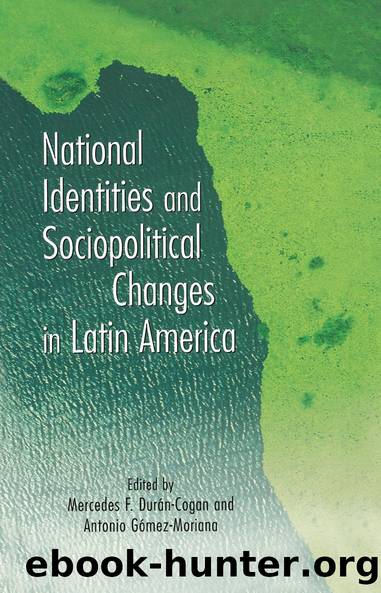National Identities and Socio-Political Changes in Latin America by Antonio Gomez-Moriana Mercedes Duran-Cogan

Author:Antonio Gomez-Moriana, Mercedes Duran-Cogan [Antonio Gomez-Moriana, Mercedes Duran-Cogan]
Language: eng
Format: epub
Tags: History, General, Political Science, History & Theory
ISBN: 9781135667665
Google: mSLfAQAAQBAJ
Publisher: Routledge
Published: 2013-10-31T01:20:18+00:00
Notes
1. My notion of Imaginary is based, first of all, on Gilbert Durandâs anthropological definition. Durand, in analyzing the organizing (26) and pluridimensional (29) dynamism of imagery, states that the latter is ârooted in a constant interchange at the level of the imaginary between the subjective and assimilating impulses and the objective stimuli emanating from the cosmic and social environmentâ (38, my translation). Equally central to my argument is also the lacanian definition of Imaginary. From this perspective the Imaginary is a transformation that occurs in the subject at the mirror stage, when it assumes the form of a discrete image that permits the postulation of a series of equivalences, analogies, identities, among the objects in the world around it (Bhabha 77. See also Hall.). My objective, however, is not so much to establish a typology of the Imaginary restricted to Moor and Christian as to call attention to its organizing and multidimensional aspect, which permits the codification of different ideological positions.
2. I will use the word Moor [moro in Spanish] in the sense that the literary tradition has given it, as much as Spanish historiography, that is to say, as a polyvalent and ambivalent term which signifies the Hispano-Arab and can include ethnic categories (North-African immigrants today), ethnographic categories (Northern Africa), as well as religious categories (Muslims). This indefinition is convenient for my argument with regard to the deployment of the stereotype as a discursive practice to articulate ideological tensions.
It is also important to define âorientalismâ here. For Said (1979, 1986), orientalism consists of a series of discursive practices based on a dialectic of information and control. These discursive practices are facilitated by the production of an imageâexotic, erotic, totalizingâof the Other (of the Orient, the oriental, the opposition to Europe) which constitutes itself as a subject of study and as a consequence into a space of intervention (in this case, British and French imperialism during the nineteenth century). Said wisely omits Spain in his analysis, and one could argue that the renewed interest in all things Moorish in the nineteenth century coincides with the decline of the Spanish empire in America. But in fact there are more coincidences than differences between Spain and western Europe in this regard since the colonizing impulse also reawakens in Spain in the nineteenth century, this time oriented towards Africa (Ricard, Morales Lezcano) accompanied, as in the British and French instances, by the emergence of a parallel academic and erudite discourse (See also Bhabha for a theoretical refocusing of Said; and my notes 7, 10, 11, and 26 below). It would also be interesting to study more closely why Spain becomes the Other of Europe in the nineteenth century, being itself so systematically orientalized.
3. Doris Summer (1992) notices the Moorish vogue in Spain, contemporaneous to Zorrilla de San Martinâs Tabaré, without establishing any connection between orientalism and the different types of indigenism commented on in the same article.
4. According to Bhabha, more than a false image that serves as scapegoat for a series
Download
This site does not store any files on its server. We only index and link to content provided by other sites. Please contact the content providers to delete copyright contents if any and email us, we'll remove relevant links or contents immediately.
Cat's cradle by Kurt Vonnegut(15186)
Pimp by Iceberg Slim(14395)
4 3 2 1: A Novel by Paul Auster(12284)
Underground: A Human History of the Worlds Beneath Our Feet by Will Hunt(12024)
The Radium Girls by Kate Moore(11921)
Wiseguy by Nicholas Pileggi(5671)
Perfect Rhythm by Jae(5324)
American History Stories, Volume III (Yesterday's Classics) by Pratt Mara L(5256)
The Fire Next Time by James Baldwin(5249)
Paper Towns by Green John(5091)
Pale Blue Dot by Carl Sagan(4912)
A Higher Loyalty: Truth, Lies, and Leadership by James Comey(4845)
The Mayflower and the Pilgrims' New World by Nathaniel Philbrick(4423)
The Doomsday Machine by Daniel Ellsberg(4416)
Killers of the Flower Moon: The Osage Murders and the Birth of the FBI by David Grann(4386)
The Sympathizer by Viet Thanh Nguyen(4305)
Too Much and Not the Mood by Durga Chew-Bose(4274)
The Borden Murders by Sarah Miller(4247)
Sticky Fingers by Joe Hagan(4101)
